Towards In-Situ Electron Microscopy Studies of Flash Sintering
Abstract
:1. Introduction
2. Materials and Methods
2.1. Green Body Specimen Preparation
2.2. ZnO Thin Films
2.3. In-Situ Test Setup
3. Results
3.1. ZnO Green Body Sintering
3.2. ZnO Thin Films
4. Discussion
5. Conclusions
Supplementary Materials
Author Contributions
Funding
Acknowledgments
Conflicts of Interest
Abbreviations
| BF | Bright field |
| DMF | Dimethylformamide |
| EDX | Energy dispersive X-ray (Spectroscopy) |
| EELS | Electron energy loss spectroscopy |
| FIB | Focused ion beam |
| FS | Flash sintering |
| GIF | Gatan imaging filter |
| HRTEM | High resolution transmission electron microscopy |
| MAD | Metalorganic aerosol deposition |
| MEMS | Micro electro-mechanical systems |
| PIPS | Precision ion polishing system |
| SEM | Scanning electron microscopy |
| TEM | Transmission electron microscopy |
Appendix A
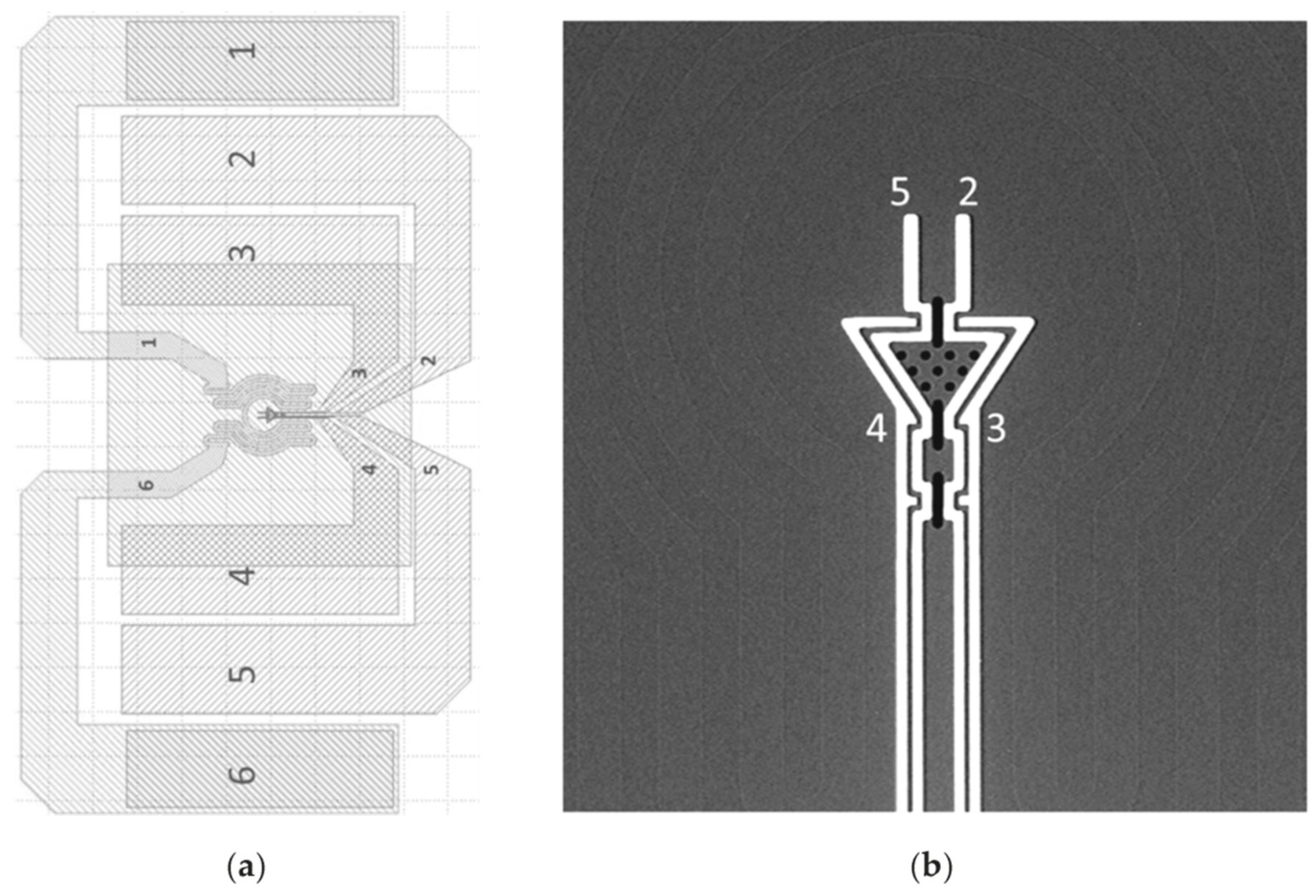
| # | Description | Stage Position | Electron Gun | Ion Gun | |||
|---|---|---|---|---|---|---|---|
| R [°] | T [°] | V [kV] | I [nA] | V [kV] | I [pA] | ||
| 1 | Window milling | 90 | 14 | 5 | 1.6 | 30 | 7000 |
| 2 | Cleaning cross section (CSS) bottom | 90 | 15.5 | 5 | 1.6 | 30 | 3000 |
| 3 | CSS top | 90 | 12.5 | 5 | 1.6 | 30 | 3000 |
| 4 | U-Cut | 270 | 20 | 5 | 1.6 | 30 | 3000 |
| 5 | Needle (Omniprobe) drive in | 90 | 14 | 5 | 1.6 | 30 | 10 |
| 6 | Mounting on Omniprobe | 90 | 14 | 5 | 1.6 | 30 | 10 |
| 7 | Lift-out/Omniprobe retract | 90 | 14 | 5 | 1.6 | 30 | 10 |
| 8 | Transfer | 90 | 14 | 10 | 2.1 | 30 | 10 |
| 9 | Mounting on chip | 90 | 14 | 10 | 2.1 | 30 | 10 |
| 10 | Cutting from Omniprobe | 90 | 14 | 10 | 2.1 | 30 | 300 |
| 11 | Thinning, front + back (raw) | 90 | 15.2/12.8 | 10 | 2.1 | 30 | 300 |
| 12 | Thinning, front + back (middle) | 90 | 15.2/12.8 | 10 | 2.1 | 30 | 100 |
| 13 | Thinning, back + front (smooth) | 90 | 13.3/14.7 | 10 | 2.1 | 30 | 30 |
| 14 | Polishing, back + front | 90 | 9/19 | 10 | 2.1 | 5 | 21 |
References
- Cologna, M.; Rashkova, B.; Raj, R. Flash Sintering of Nanograin Zirconia in <5 s at 850 °C: Rapid Communications of the American Ceramic Society. J. Am. Ceram. Soc. 2010, 93, 3556–3559. [Google Scholar]
- Downs, J.A.; Sglavo, V.M. Electric Field Assisted Sintering of Cubic Zirconia at 390 °C. J. Am. Ceram. Soc. 2013, 96, 1342–1344. [Google Scholar] [CrossRef]
- Lebrun, J.-M.; Raj, R. A First Report of Photoemission in Experiments Related to Flash Sintering. J. Am. Ceram. Soc. 2014, 97, 2427–2430. [Google Scholar] [CrossRef]
- Biesuz, M.; Luchi, P.; Quaranta, A.; Martucci, A.; Sglavo, V.M. Photoemission during flash sintering: An interpretation based on thermal radiation. J. Eur. Ceram. Soc. 2017, 37, 3125–3130. [Google Scholar] [CrossRef]
- Gonzalez-Julian, J.; Guillon, O. Effect of Electric Field/Current on Liquid Phase Sintering. J. Am. Ceram. Soc. 2015, 98, 2018–2027. [Google Scholar] [CrossRef]
- Biesuz, M.; Sglavo, V.M. Current-induced abnormal and oriented grain growth in corundum upon flash sintering. Scr. Mater. 2018, 150, 82–86. [Google Scholar] [CrossRef]
- Charalambous, H.; Jha, S.K.; Wang, H.; Phuah, X.L.; Wang, H.; Tsakalakos, T. Inhomogeneous reduction and its relation to grain growth of titania during flash sintering. Scr. Mater. 2018, 155, 37–40. [Google Scholar] [CrossRef]
- M’Peko, J.-C.; Francis, J.S.; Raj, R. Field-assisted sintering of undoped BaTiO3: Microstructure evolution and dielectric permittivity. J. Eur. Ceram. Soc. 2014, 34, 3655–3660. [Google Scholar] [CrossRef]
- Nakagawa, Y.; Yoshida, H.; Uehashi, A.; Tokunaga, T.; Sasaki, K.; Yamamoto, T. Electric current-controlled synthesis of BaTiO3. J. Am. Ceram. Soc. 2017, 100, 3843–3850. [Google Scholar] [CrossRef]
- Li, J.; Guan, L.; Zhang, W.; Luo, M.; Song, J.; Song, X.; An, S. Sintering behavior of samarium doped ceria under DC electrical field. Ceram. Int. 2018, 44, 2470–2477. [Google Scholar] [CrossRef]
- Valdebenito, J.U.; Akbari-Fakhrabadi, A.; Viswanathan, M.R. Effect of flash sintering on microstructure of Ce0.9Gd0.1O1.95 electrolyte fabricated by tape-casting. Mater. Lett. 2017, 209, 291–294. [Google Scholar] [CrossRef]
- Spiridigliozzi, L.; Biesuz, M.; Dell’Agli, G.; Di Bartolomeo, E.; Zurlo, F.; Sglavo, V.M. Microstructural and electrical investigation of flash-sintered Gd/Sm-doped ceria. J. Mater. Sci. 2017, 52, 7479–7488. [Google Scholar] [CrossRef]
- Biesuz, M.; Dell’Agli, G.; Spiridigliozzi, L.; Ferone, C.; Sglavo, V.M. Conventional and field-assisted sintering of nanosized Gd-doped ceria synthesized by co-precipitation. Ceram. Int. 2016, 42, 11766–11771. [Google Scholar] [CrossRef]
- Muccillo, R.; Muccillo, E.N.S. Shrinkage control of yttria-stabilized zirconia during ac electric field-assisted sintering. J. Eur. Ceram. Soc. 2014, 34, 3871–3877. [Google Scholar] [CrossRef]
- Ji, W.; Parker, B.; Falco, S.; Zhang, J.Y.; Fu, Z.Y.; Todd, R.I. Ultra-fast firing: Effect of heating rate on sintering of 3YSZ, with and without an electric field. J. Eur. Ceram. Soc. 2017, 37, 2547–2551. [Google Scholar] [CrossRef]
- Carvalho, S.; Muccillo, E.; Muccillo, R. Electrical Behavior and Microstructural Features of Electric Field-Assisted and Conventionally Sintered 3 moL% Yttria-Stabilized Zirconia. Ceramics 2018, 1, 2. [Google Scholar] [CrossRef]
- Muccillo, R.; Muccillo, E.N.S. Electric field-assisted flash sintering of tin dioxide. J. Eur. Ceram. Soc. 2014, 34, 915–923. [Google Scholar] [CrossRef]
- Dargatz, B.; Gonzalez-Julian, J.; Guillon, O. Effect of electric field and atmosphere on the processing of nanocrystalline ZnO. In Oxide-Based Materials and Devices V; International Society for Optics and Photonics; SPIE: San Francisco, CA, USA, 2014; Volume 8987, p. 89871H. [Google Scholar]
- Luo, J. The scientific questions and technological opportunities of flash sintering: From a case study of ZnO to other ceramics. Scr. Mater. 2018, 146, 260–266. [Google Scholar] [CrossRef]
- Nie, J.; Zhang, Y.; Chan, J.M.; Huang, R.; Luo, J. Water-assisted flash sintering: Flashing ZnO at room temperature to achieve ~98% density in seconds. Scr. Mater. 2018, 142, 79–82. [Google Scholar] [CrossRef]
- Nie, J.; Zhang, Y.; Chan, J.M.; Jiang, S.; Huang, R.; Luo, J. Two-step flash sintering of ZnO: Fast densification with suppressed grain growth. Scr. Mater. 2017, 141, 6–9. [Google Scholar] [CrossRef]
- Gao, H.; Asel, T.J.; Cox, J.W.; Zhang, Y.; Luo, J.; Brillson, L.J. Native point defect formation in flash sintered ZnO studied by depth-resolved cathodoluminescence spectroscopy. J. Appl. Phys. 2016, 120, 105302. [Google Scholar] [CrossRef]
- Zhang, Y.; Luo, J. Promoting the flash sintering of ZnO in reduced atmospheres to achieve nearly full densities at furnace temperatures of <120 °C. Scr. Mater. 2015, 106, 26–29. [Google Scholar]
- Zhang, Y.; Jung, J.-I.; Luo, J. Thermal runaway, flash sintering and asymmetrical microstructural development of ZnO and ZnO–Bi2O3 under direct currents. Acta Mater. 2015, 94, 87–100. [Google Scholar] [CrossRef]
- Schmerbauch, C.; Gonzalez-Julian, J.; Röder, R.; Ronning, C.; Guillon, O. Flash Sintering of Nanocrystalline Zinc Oxide and its Influence on Microstructure and Defect Formation. J. Am. Ceram. Soc. 2014, 97, 1728–1735. [Google Scholar] [CrossRef]
- Todd, R.I. Electrical characteristics of flash sintering: Thermal runaway of Joule heating. J. Eur. Ceram. Soc. 2015, 35, 1865–1877. [Google Scholar] [CrossRef]
- da Silva, J.G.P.; Al-Qureshi, H.A.; Keil, F.; Janssen, R. A dynamic bifurcation criterion for thermal runaway during the flash sintering of ceramics. J. Eur. Ceram. Soc. 2016, 36, 1261–1267. [Google Scholar] [CrossRef]
- Naik, K.S. Flash sintering as a nucleation phenomenon and a model thereof. J. Eur. Ceram. Soc. 2014, 34, 4063–4067. [Google Scholar] [CrossRef]
- Du, Y. Estimating Joule heating and ionic conductivity during flash sintering of 8YSZ. J. Eur. Ceram. Soc. 2016, 36, 749–759. [Google Scholar] [CrossRef]
- Zapata-Solvas, E.; Gómez-García, D.; Domínguez-Rodríguez, A.; Todd, R.I. Ultra-fast and energy-efficient sintering of ceramics by electric current concentration. Sci. Rep. 2015, 5, 8513. [Google Scholar] [CrossRef] [PubMed]
- Chaim, R. Liquid Film Capillary Mechanism for Densification of Ceramic Powders during Flash Sintering. Materials 2016, 9, 280. [Google Scholar] [CrossRef] [PubMed]
- Chaim, R. Particle Surface Softening as Universal Behaviour during Flash Sintering of Oxide Nano-Powders. Materials 2017, 10, 179. [Google Scholar] [CrossRef]
- Narayan, J. A new mechanism for field-assisted processing and flash sintering of materials. Scr. Mater. 2013, 69, 107–111. [Google Scholar] [CrossRef]
- Wang, J.; Cao, J.; Fang, B.; Lu, P.; Deng, S.; Wang, H. Synthesis and characterization of multipod, flower-like, and shuttle-like ZnO frameworks in ionic liquids. Mater. Lett. 2005, 59, 1405–1408. [Google Scholar] [CrossRef]
- Bacaksiz, E.; Parlak, M.; Tomakin, M.; Özçelik, A.; Karakız, M.; Altunbaş, M. The effects of zinc nitrate, zinc acetate and zinc chloride precursors on investigation of structural and optical properties of ZnO thin films. J. Alloys Compd. 2008, 466, 447–450. [Google Scholar] [CrossRef]
- Schwarz, S.; Thron, A.M.; Rufner, J.; Benthem, K.; Guillon, O. Low Temperature Sintering of Nanocrystalline Zinc Oxide: Effect of Heating Rate Achieved by Field Assisted Sintering/Spark Plasma Sintering. J. Am. Ceram. Soc. 2012, 95, 2451–2457. [Google Scholar] [CrossRef]
- Cramer, C.L.; Gonzalez-Julian, J.; Colasuonno, P.S.; Holland, T.B. Continuous functionally graded material to improve the thermoelectric properties of ZnO. J. Eur. Ceram. Soc. 2017, 37, 4693–4700. [Google Scholar] [CrossRef]
- Gao, L.; Li, Q.; Luan, W.; Kawaoka, H.; Sekino, T.; Niihara, K. Preparation and Electric Properties of Dense Nanocrystalline Zinc Oxide Ceramics. J. Am. Ceram. Soc. 2004, 85, 1016–1018. [Google Scholar] [CrossRef]
- Wang, J.; Gao, L. Photoluminescence Properties of Nanocrystalline ZnO Ceramics Prepared by Pressureless Sintering and Spark Plasma Sintering. J. Am. Ceram. Soc. 2005, 88, 1637–1639. [Google Scholar] [CrossRef]
- Dargatz, B.; Gonzalez-Julian, J.; Bram, M.; Shinoda, Y.; Wakai, F.; Guillon, O. FAST/SPS sintering of nanocrystalline zinc oxide—Part II: Abnormal grain growth, texture and grain anisotropy. J. Eur. Ceram. Soc. 2016, 36, 1221–1232. [Google Scholar] [CrossRef]
- Igasaki, Y.; Saito, H. The effects of deposition rate on the structural and electrical properties of ZnO: Al films deposited on (
) oriented sapphire substrates. J. Appl. Phys. 1991, 70, 3613–3619. [Google Scholar] [CrossRef]
- Lu, L.; Wong, M. The Resistivity of Zinc Oxide under Different Annealing Configurations and Its Impact on the Leakage Characteristics of Zinc Oxide Thin-Film Transistors. IEEE Trans. Electron Devices 2014, 61, 1077–1084. [Google Scholar] [CrossRef]
- Gonzalez-Julian, J.; Neuhaus, K.; Bernemann, M.; Pereira da Silva, J.; Laptev, A.; Bram, M.; Guillon, O. Unveiling the mechanisms of cold sintering of ZnO at 250 °C by varying applied stress and characterizing grain boundaries by Kelvin Probe Force Microscopy. Acta Mater. 2018, 144, 116–128. [Google Scholar] [CrossRef]
- Donnay, G.; Kihara, K. Anharmonic thermal vibrations in ZnO. Can. Mineral. 1985, 23, 647–654. [Google Scholar]
- Moshnyaga, V.; Khoroshun, I.; Sidorenko, A.; Petrenko, P.; Weidinger, A.; Zeitler, M.; Rauschenbach, B.; Tidecks, R.; Samwer, K. Preparation of rare-earth manganite-oxide thin films by metalorganic aerosol deposition technique. Appl. Phys. Lett. 1999, 74, 2842–2844. [Google Scholar] [CrossRef]
- Jungbauer, M.; Hühn, S.; Egoavil, R.; Tan, H.; Verbeeck, J.; Van Tendeloo, G.; Moshnyaga, V. Atomic layer epitaxy of Ruddlesden-Popper SrO(SrTiO3)n films by means of metalorganic aerosol deposition. Appl. Phys. Lett. 2014, 105, 251603. [Google Scholar] [CrossRef]
- Zintler, A.; Kunz, U.; Pivak, Y.; Sharath, S.U.; Vogel, S.; Hildebrandt, E.; Kleebe, H.-J.; Alff, L.; Molina-Luna, L. FIB based fabrication of an operative Pt/HfO 2 /TiN device for resistive switching inside a transmission electron microscope. Ultramicroscopy 2017, 181, 144–149. [Google Scholar] [CrossRef]
- Pérez Garza, H.H.; Zuo, K.; Pivak, Y.; Morsink, D.; Zakhozheva, M.; Pen, M.; van Weperen, S.; Xu, Q. MEMS-Based System for In-Situ Biasing and Heating Solutions inside the TEM. Available online: https://onlinelibrary.wiley.com/doi/pdf/10.1002/9783527808465.EMC2016.6710 (accessed on 3 April 2019).
- Zhang, L.; Zhu, L.; Li, X.; Xu, Z.; Wang, W.; Bai, X. Resistive switching mechanism in the one diode-one resistor memory based on p+-Si/n-ZnO heterostructure revealed by in-situ TEM. Sci. Rep. 2017, 7, 45143. [Google Scholar] [CrossRef] [Green Version]
- Jongmanns, M.; Raj, R.; Wolf, D.E. Generation of Frenkel defects above the Debye temperature by proliferation of phonons near the Brillouin zone edge. New J. Phys. 2018, 20, 093013. [Google Scholar] [CrossRef]
- Hu, C.; Wang, Q.; Bai, S.; Xu, M.; He, D.; Lyu, D.; Qi, J. The effect of oxygen vacancy on switching mechanism of ZnO resistive switching memory. Appl. Phys. Lett. 2017, 110, 073501. [Google Scholar] [CrossRef]
- Lee, J.S.; Lee, S.; Noh, T.W. Resistive switching phenomena: A review of statistical physics approaches. Appl. Phys. Rev. 2015, 2, 031303. [Google Scholar] [CrossRef] [Green Version]
- Madelung, O.; Schulz, M.; Rössler, U. II-VI and I-VII Compounds—Semimagnetic Compounds—Zinc Oxide (ZnO) Debye Temperature, Heat Capacity, Density, Melting Point, Vapor Pressure, Hardness; Landolt-Börnstein-Group III Condensed Matter; Springer: Berlin/Heidelberg, Germany, 1999; ISBN 978-3-540-31359-5. [Google Scholar]
- Mishra, T.P.; Avila, V.; Neto, R.R.I.; Brams, M.; Guillon, O.; Raj, R. On the role of Debye temperature in the onset of flash in three oxides. Scr. Mater. 2019, 170, 81–84. [Google Scholar] [CrossRef]
- Pivak, Y. Lightning System—Nano-Chip Contacts and Interconnect Unit Connectors Numbering—Manual—Version 1.2; DENSsolutions: Delft, The Netherlands, 2017. [Google Scholar]
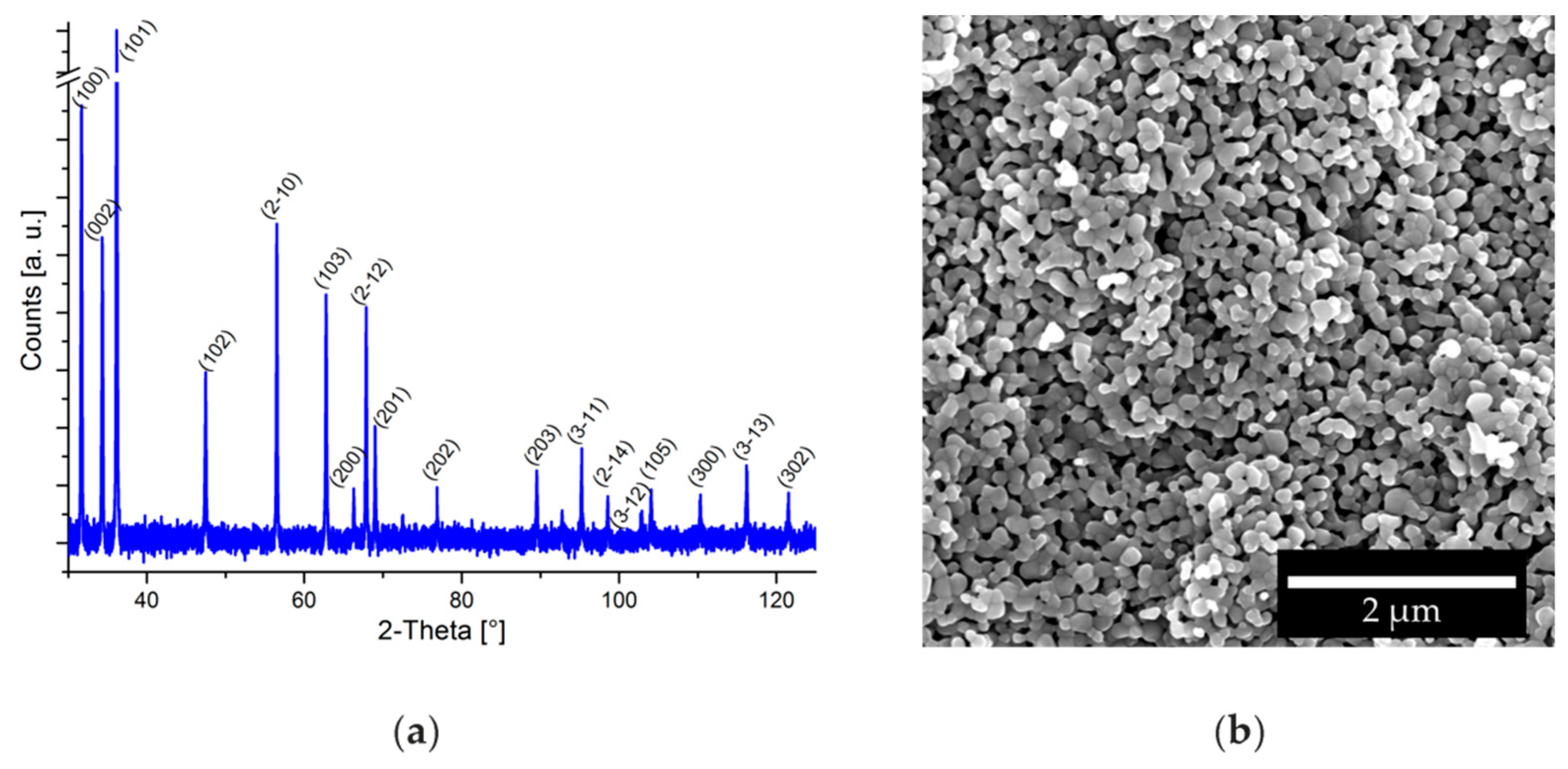
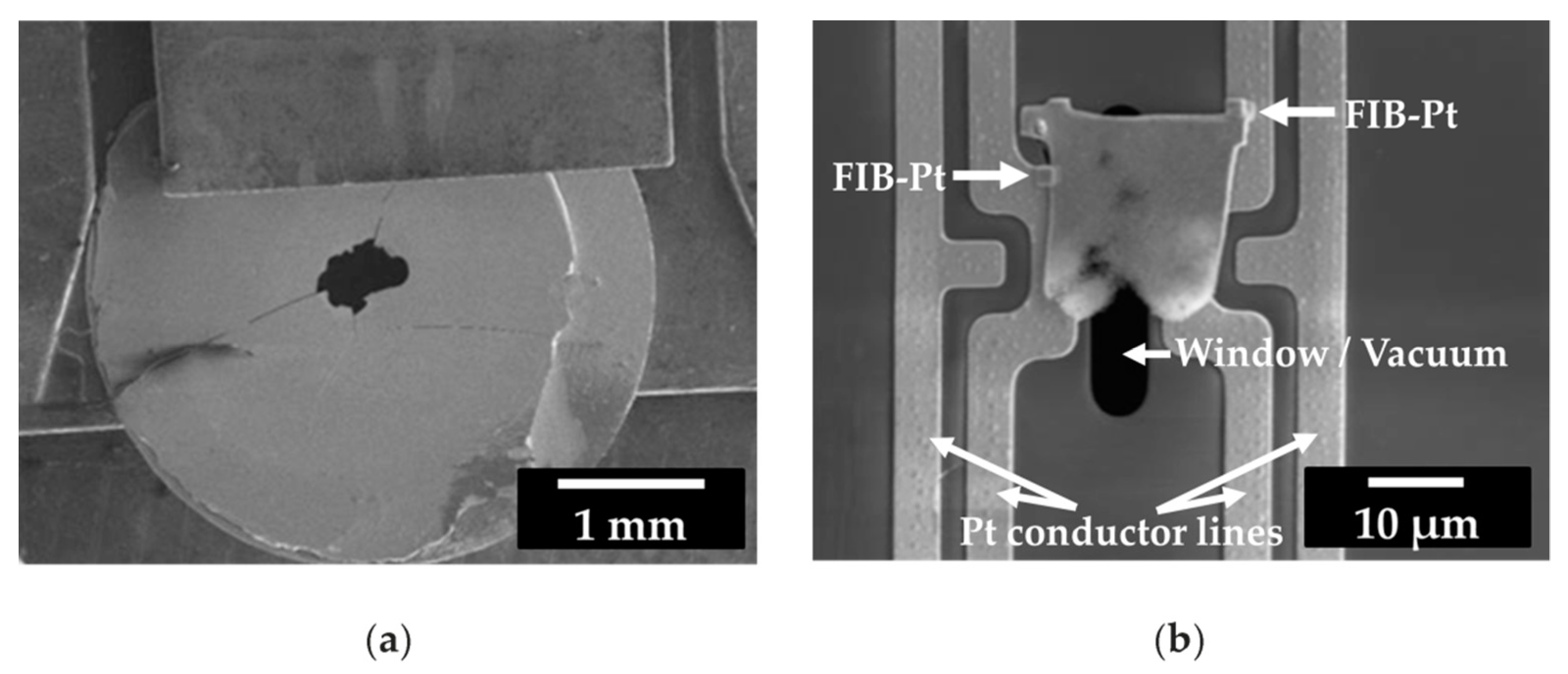
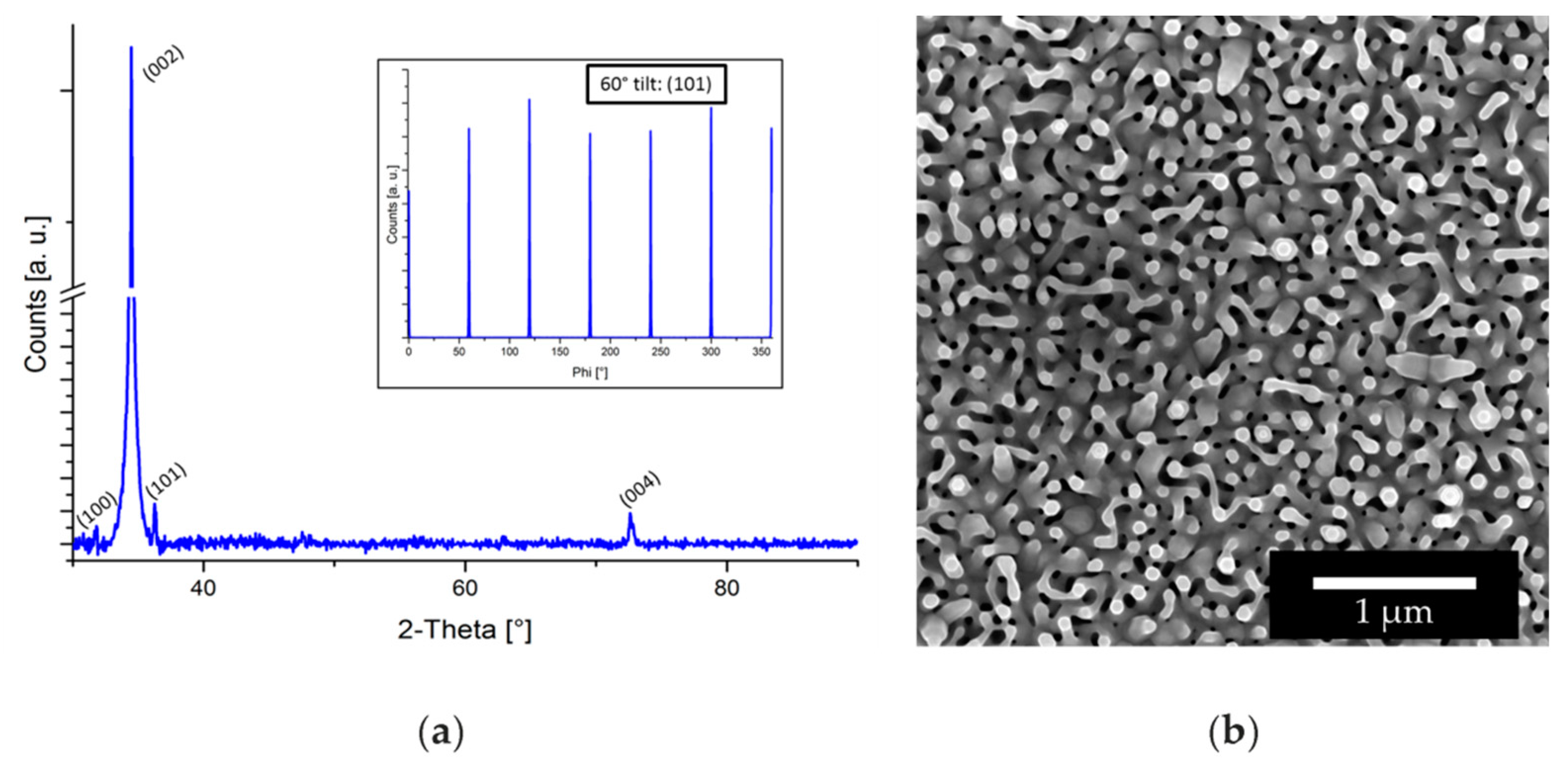
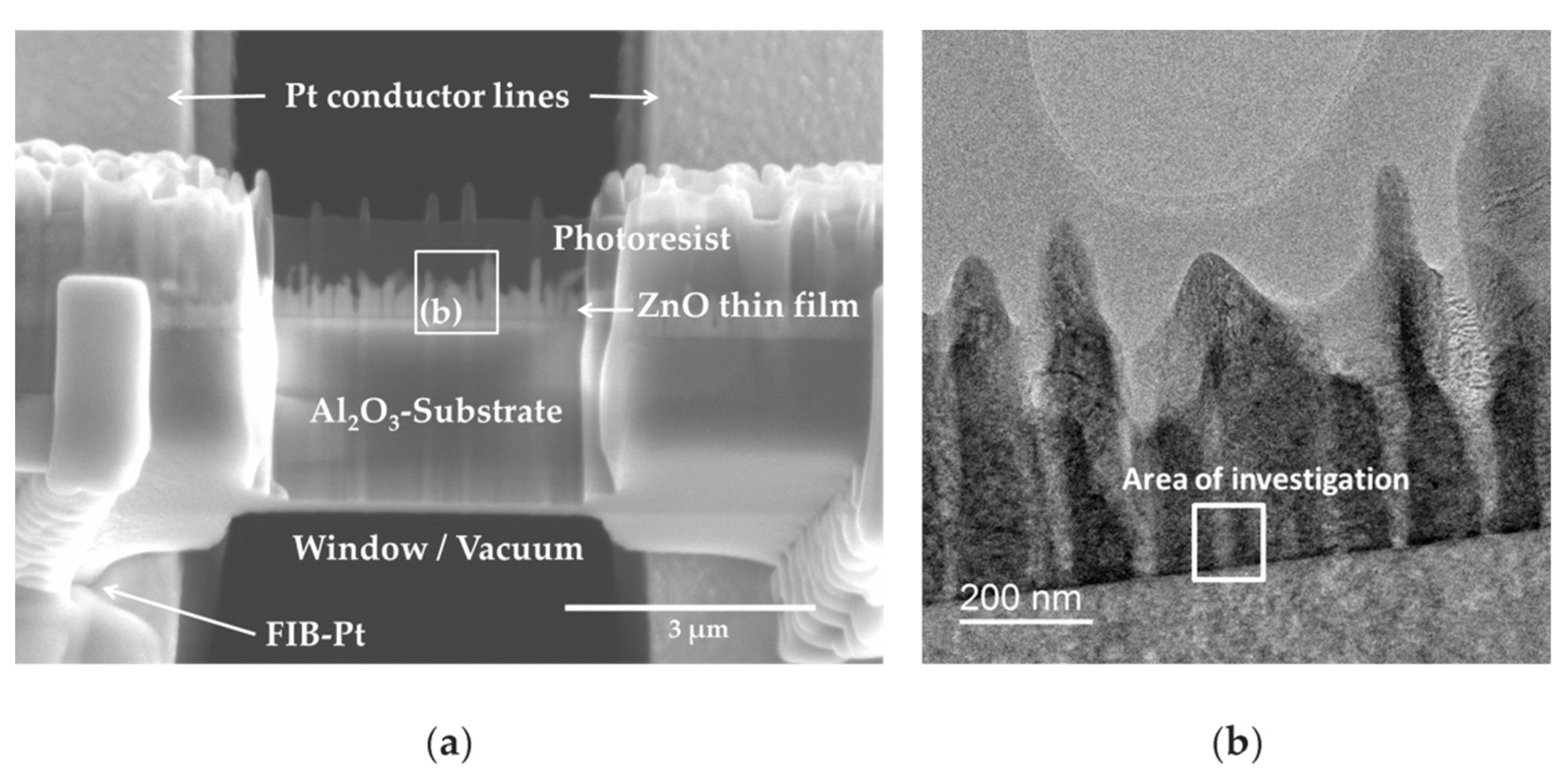
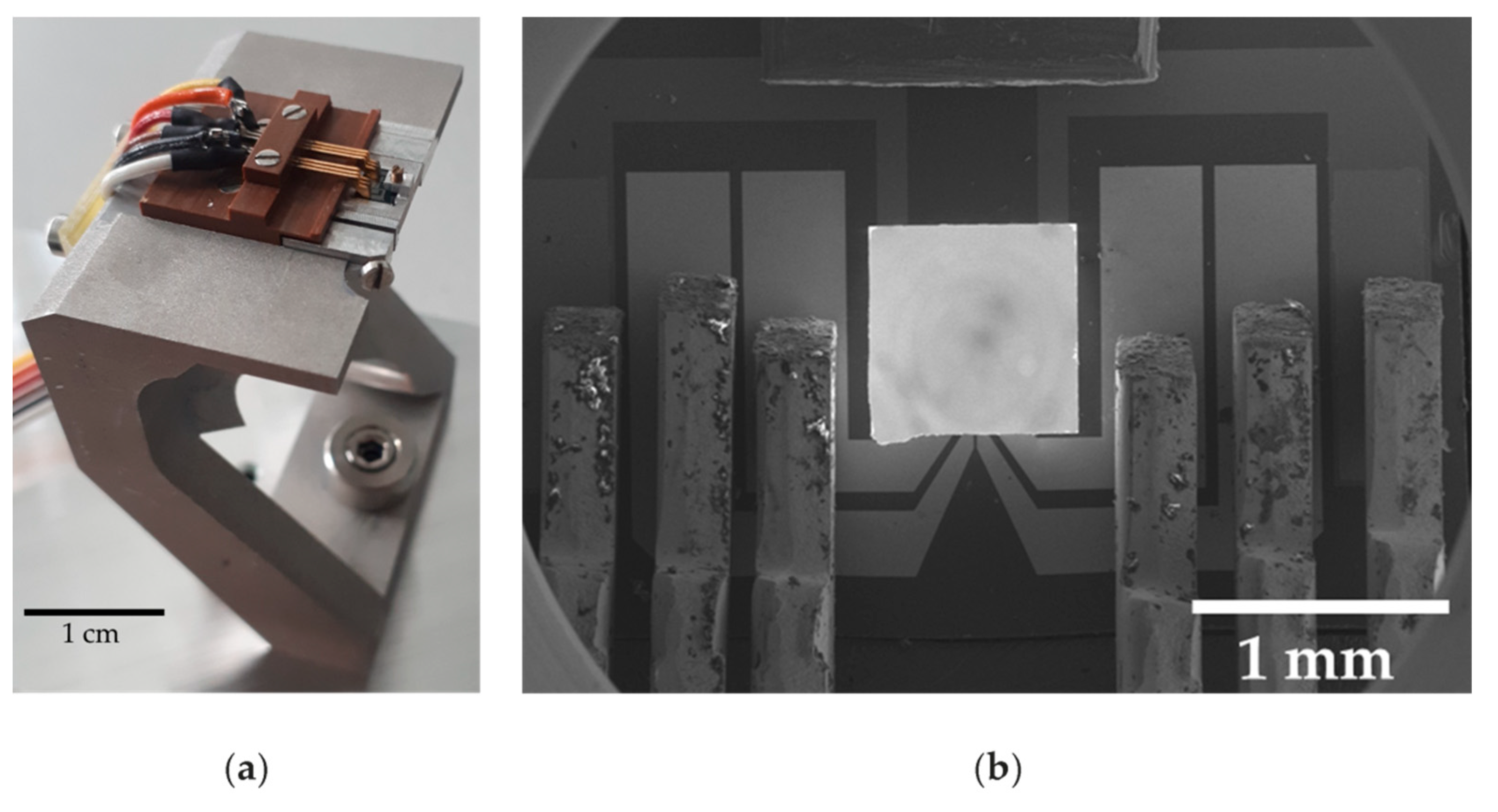
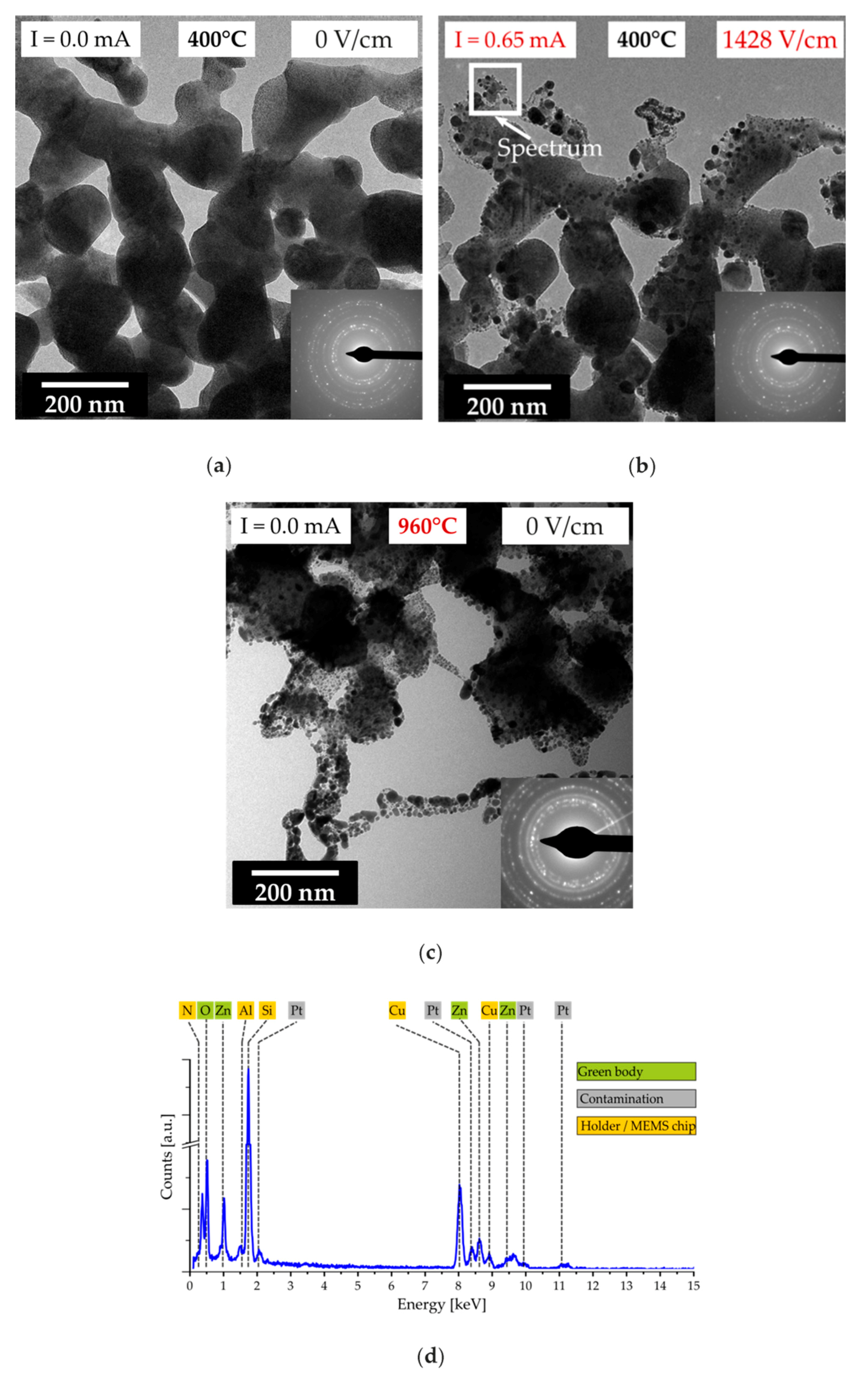
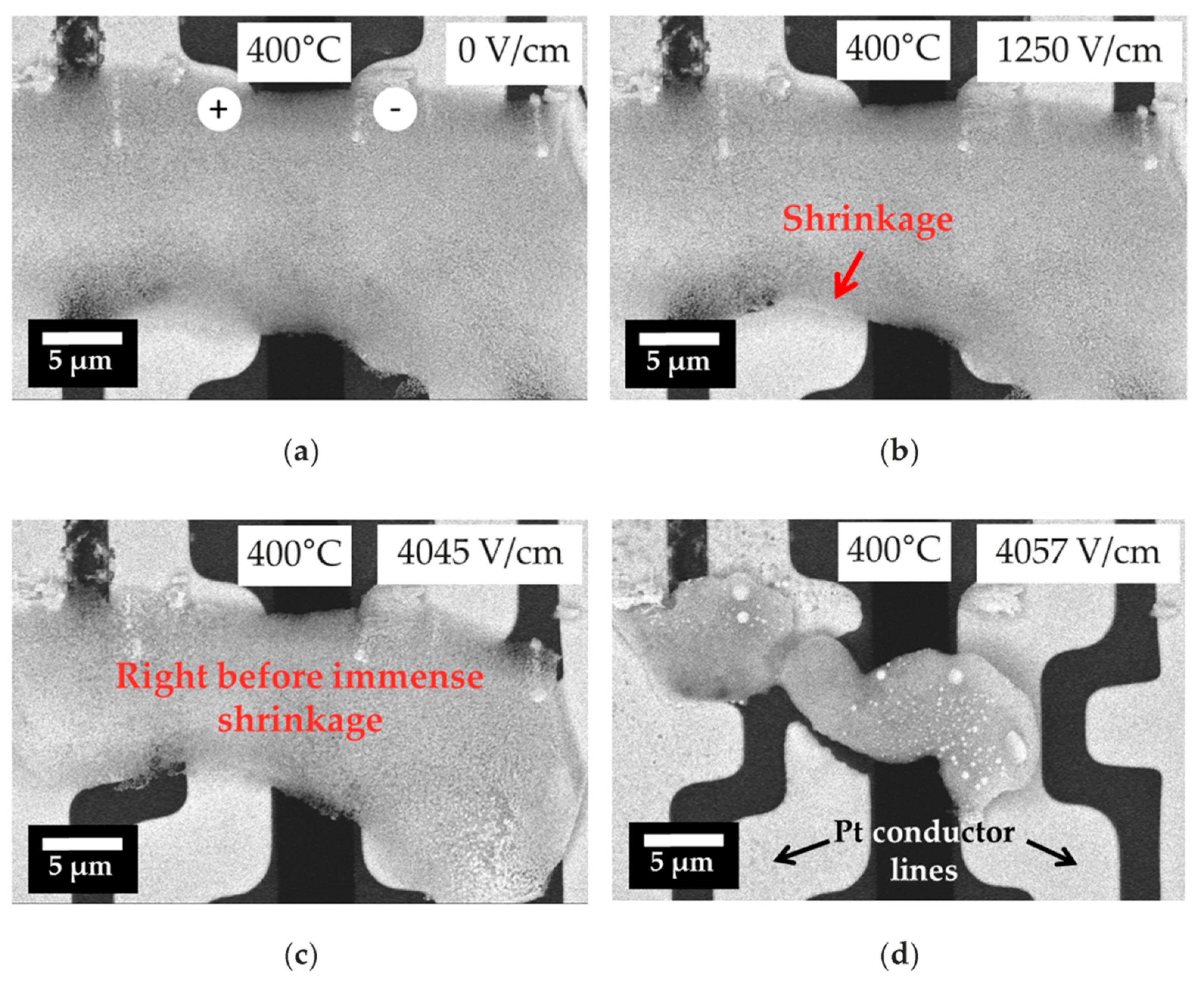
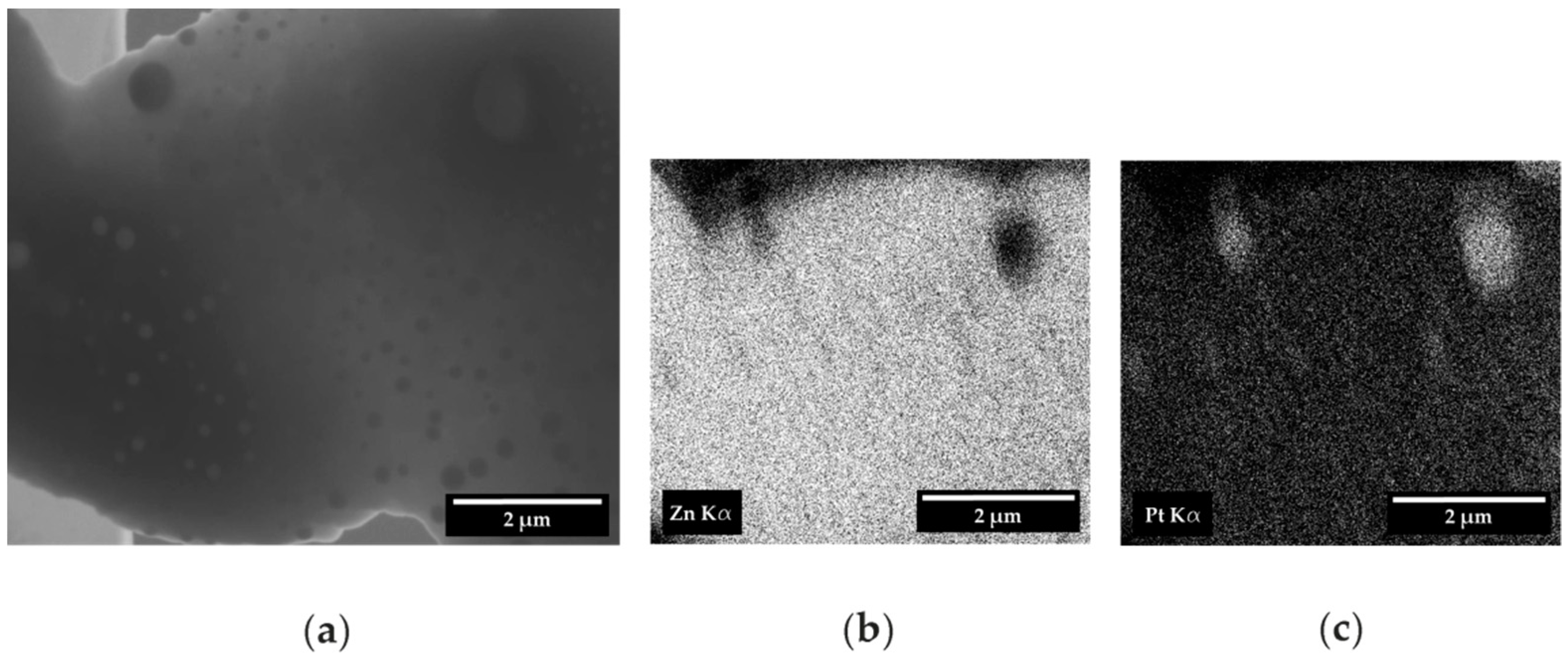
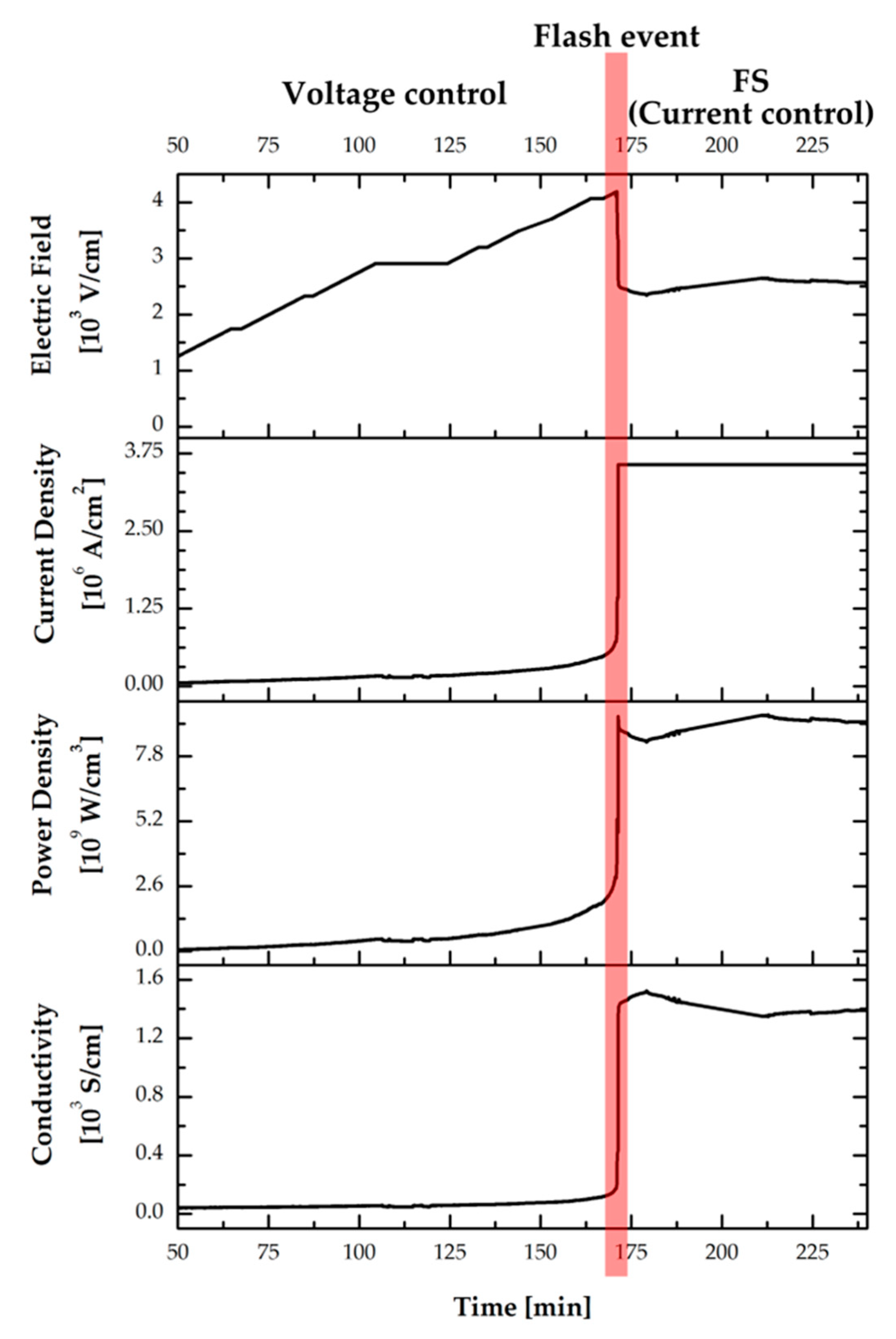
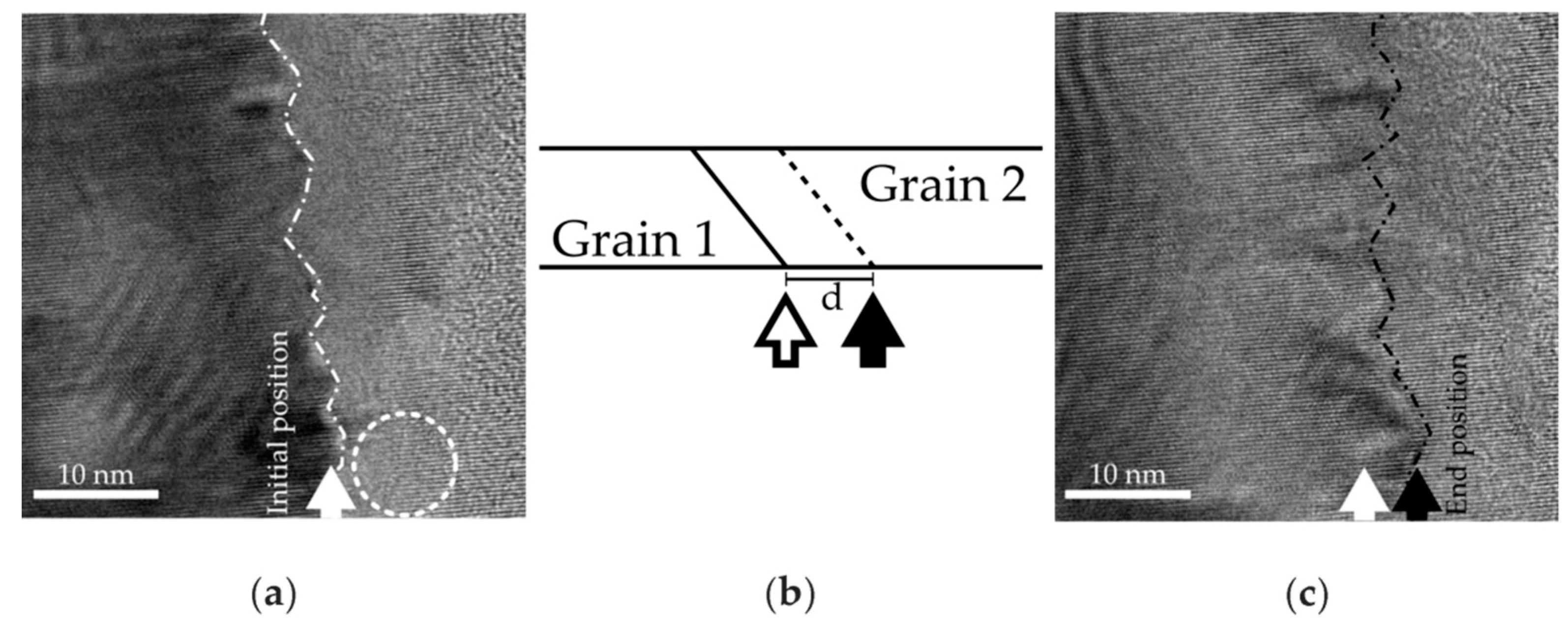
© 2019 by the authors. Licensee MDPI, Basel, Switzerland. This article is an open access article distributed under the terms and conditions of the Creative Commons Attribution (CC BY) license (http://creativecommons.org/licenses/by/4.0/).
Share and Cite
Schwarzbach, D.; Gonzalez-Julian, J.; Guillon, O.; Roddatis, V.; Volkert, C.A. Towards In-Situ Electron Microscopy Studies of Flash Sintering. Ceramics 2019, 2, 472-487. https://doi.org/10.3390/ceramics2030036
Schwarzbach D, Gonzalez-Julian J, Guillon O, Roddatis V, Volkert CA. Towards In-Situ Electron Microscopy Studies of Flash Sintering. Ceramics. 2019; 2(3):472-487. https://doi.org/10.3390/ceramics2030036
Chicago/Turabian StyleSchwarzbach, Danny, Jesus Gonzalez-Julian, Olivier Guillon, Vladimir Roddatis, and Cynthia A. Volkert. 2019. "Towards In-Situ Electron Microscopy Studies of Flash Sintering" Ceramics 2, no. 3: 472-487. https://doi.org/10.3390/ceramics2030036
APA StyleSchwarzbach, D., Gonzalez-Julian, J., Guillon, O., Roddatis, V., & Volkert, C. A. (2019). Towards In-Situ Electron Microscopy Studies of Flash Sintering. Ceramics, 2(3), 472-487. https://doi.org/10.3390/ceramics2030036







